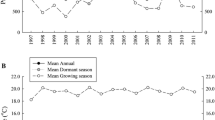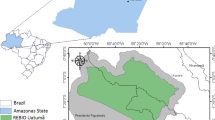Abstract
We tested the hypothesis that management actions that alter floodplain plant communities will modify the effects of flooding on gross nitrification, a key process regulating the flux of nitrate along river-floodplains. Soils were collected from mature forests, patches of Phalaris arundinacea, an exotic grass, and areas restored to early successional forest (unbrowsed and browsed) in the Upper Mississippi River floodplain. Samples were collected across an elevation gradient and along the descending limb of the hydrograph to test for effects of flooding. In all three forest types, soil properties were less favorable for nitrification as elevation increased, due to decreasing organic matter, porosity, total nitrogen, and temperature. In contrast, Phalaris maintained high soil organic matter and porosity as floodplain elevation increased. Corresponding with the differences in soil properties found in forested plots, the highest rates of potential gross nitrification were found in the lower elevation sites immediately following the spring flood (1–8 days post inundation). These high rates were later followed by a rapid decline in both NH4 +-N and nitrification with increasing time since inundation (>11 days post inundation). Nitrification rates were also highest following the flood in Phalaris sites, but rates did not depend on elevation, likely because of the lack of elevational differences in soil properties. Our results generally support the flood-pulse concept of river-floodplain connectivity, with the highest nitrification rates found in areas and during times immediately following inundation. Furthermore, restoration of forest cover in areas invaded by Phalaris appears likely to restore flood-pulse effects on abiotic soil properties and nitrification dynamics.






Similar content being viewed by others
References
Annen CA (2008) Effects of tillage and growth regulator pretreatments on reed canarygrass (Phalaris arundinacea L.) control with Sethoxydim. Nat Areas J 28:6–13
Austin BJ, Strauss EA (2011) Nitrification and denitrification response to varying periods of desiccation and inundation in a western Kansas stream. Hydrobiologia 658:183–195
Baldwin DS, Mitchell AM (2000) The effects of drying and reflooding on the sediment and soil nutrient dynamics of lowland river floodplain systems: a synthesis. Regul Rivers 6:457–467
Blake GR, Hartge KH (1986) Particle density. In: Klute A (ed) Methods of soil analysis. Part 1, physical and mineralogicald methods, 2nd edn. American Society of Agronomy, Madison, pp 377–382
Burnham KP, Anderson DR (2001) Kullback–Leibler information as a basis for strong inference in ecological studies. Wildl Res 28:111–119
Butler LM, Kielland K (2008) Acceleration of vegetation turnover and element cycling by mammalian herbivory in riparian ecosystems. J Ecol 96:136–144
Cavanaugh JC, Richardson WB, Strauss EA, Bartsch LA (2006) Nitrogen dynamics in sediment during water level manipulation on the Upper Mississippi River. River Res Appl 22:651–666
Cogger BJ, De Jager NR, Thomsen MT (2014) Winter browse selection by white-tailed deer and implications for bottomland forest restoration in the Upper Mississippi River valley, USA. Natl Areas J 34:500–509
Conchou O, Fustec E (1988) Influence of hydrological fluctuations on the growth and nutrient dynamics of Phalaris arundinacea L. in a riparian environment. Plant Soil 112:53–60
Craig LS, Palmer MA, Richardson DC, Filoso S, Bernhardt ES, Bledsoe BP, Doyle MW, Groffman PM, Hassett RA, Kaushall SS, Mayer PM, Smith SM, Wilcock PR (2008) Stream restoration strategies for reducing river nitrogen loads. Front Ecol Environ 6:529–538
De Jager NR, Cogger BJ, Thomsen MA (2013) Interactive effects of flooding and deer (Odocoileus virginianus) browsing on floodplain forest recruitment. For Ecol Manag 303:11–19
Edwards KR, Cižková H, Zemanová K, Šantručková H (2006) Plant growth and microbial processes in a constructed wetland planted with Phalaris arundinacea. Ecol Eng 27:153–165
Ehrenfeld JG (2001) Effects of exotic plant invasions on soil nutrient cycling processes. Ecosystems 6:503–523
Eppinga MB, Kaproth MA, Collins AR, Molofsky J (2011) Litter feedbacks, evolutionary change and exotic plant invasion. J Ecol 99:503–514
Forshay KJ, Dodson SI (2011) Macrophyte presence is an indicator of enhanced denitrification and nitrification in sediments of a temperate restored agricultural stream. Hydrobiologia 668:21–34
Frank DA, Groffman PM, Evans RD, Tracy BF (2000) Ungulate stimulation of nitrogen cycling and retention in Yellowstone Park grasslands. Oecologia 123:116–121
Gilmour JT (1984) The effects of soil properties on nitrification and denitrification inhibition. Soil Sci Soc Am J 48:1262–1266
Jicha TM, Johnson LB, Hill BH, Regal RR, Elonen CM, Pearson MS (2013) Spatial and temporal patterns in nitrification rates in forested floodplain wetland soils of Upper Mississippi River Pool 8. River Res Appl. doi:10.1002/rra.2663
Junk WJ, Bayley PB, Sparks RE (1989) The flood pulse concept in river–floodplain systems. Can Spec Publ Fishries Aquat Sci 106:110–127
Kaushal SS, Groffman PM, Mayer PM, Striz E, Gold AJ (2008) Effects of stream restoration on denitrification in an urbanizing watershed. Ecol Appl 18:789–804
Lavergne S, Molofsky J (2004) Reed canarygrass (Phalaris arundinacea) as a biological model in the study of plant invasions. Crit Rev Plant Sci 23:415–429
Linn DM, Doran JW (1984) Effects of water filled pore space on carbon dioxide and nitrous oxide production in filled and non-filled soils. Soil Sci Soc Am J 48:1267–1272
Mack MC, D’Antonio CM (2003) Exotic grasses alter controls over soil nitrogen dynamics in a Hawaiian woodland. Ecol Appl 13:154–166
Malhi SS, McGill WB (1982) Nitrification in three Alberta soils: effect of temperature, moisture, and substrate concentration. Soil Biol Biochem 14:393–399
Naiman RJ, Décamps H (eds) (1990) The ecology and management of aquatic terrestrial ecotones. Parthenon, Pearl River, New York
Noe GB, Hupp CR, Rybicki NB (2013) Hydrogeomorphology influences soil nitrogen and phosphorous mineralization in floodplain wetlands. Ecoystems 16:75–94
Parton WJ, Mosier AR, Schimel DS (1988) Rates and pathways of nitrous oxide production in shortgrass steppe. Biogeochemistry 6:45–58
Parton WJ, Mosier AR, Ojima DS, Valentine DW, Schimel DS, Weier K, Kulmala AE (1996) Generalized model for N2 and N2O production from nitrification and denitrification. Global Biogeochem Cycles 10:401–412
Pastor J, Dewey B, Naiman RJ, McInnes PF, Cohen Y (1993) Moose browsing and soil fertility in the boreal forests of Isle Royale National Park. Ecology 74:467–480
Pinay G, Gumiero B, Tabacchi E, Gimenz O, Tabacchi-Planty AM, Hefting MM, Burt TP, Black VA, Nilsson C, Iordache V, Bureau F, Vought L, Petts GC, Decamps H (2007) Patterns of denitrificationrates in European alluvial soils under various hydrologic regimes. Freshw Biol 52:252–266
R Core Team (2013) R: A language and environment for statistical computing. R Foundation for Statistical Computing, Vienna. http://www.R-project.org/
Reinhardt Adams C, Galatowitsch SM (2006) Increasing the effectiveness of reed canarygrass (Phalaris arundinacea L.) control in wet meadow restorations. Restor Ecol 14:441–451
Robertson GP, Coleman DC, Bledsoe CS, Sollins P (1999) Standard soil methods for long-term ecological research. Oxford University Press, Oxford
Romano SP (2010) Our current understanding of the Upper Mississippi River System floodplain forest. Hydrobiologia 640:115–124
Ruess RW, McNaughton SJ (1987) Grazing and the dynamics of nutrient and energy regulated microbial processes in the Serengeti grasslands. Oikos 49:101–110
Sabey BR, Frederick L, Bartholomew R (1959) The formation of nitrate from ammonium in soils, III, Influence of termperature and initial population of nitrifying organisms on the maximum rate and delay period. Soil Sci Soc Am J 23:462–465
Schlosser IJ, Karr JR (1981) Water quality in agricultural watersheds: impact of riparian vegetation during baseflow. Water Resour Bull 17:233–240
Shrestha J, Niklaus PA, Frossar E, Samaritani E, Huber B, Barnard RL, Schleppi P, Tockner K, Luster J (2012) Soil nitrogen dynamics in a river floodplain mosaic. J Environ Qual 41:2033–2045
Strauss EA, Lamberti GA (2000) Regulation of nitrification in aquatic sediments by organic carbon. Limnol Oceanogr 45:1854–1859
Strauss EA, Mitchell NL, Lamberti GA (2002) Factors regulating nitrification in aquatic sediments: effects of organic carbon, nitrogen availability, and pH. Can J Fish Aquat Sci 59:554–563
Strauss EA, Richardson WB, Bartsch LA, Cavanaugh JC, Brusewitz DA, Imker H, Heinz JA, Soballe DM (2004) Nitrification in the Upper Mississippi River: patterns, controls, and contribution to the nitrate budget. J North Am Benthol Soc 23:1–14
Thomsen M, Brownell K, Urich R, Groshek M, Kirsch E (2012) Control of reed canarygrass promotes wetland herb and tree seedling establishment in Upper Mississippi River floodplain. Wetlands 32:543–555
Tockner K, Malard F, Ward JV (2000) An extension of the flood pulse concept. Hydrol Process 14:2861–2883
Vitousek PM, Gosz JR, Grier CC, Melillo JM, Reiners WA (1982) A comparative analysis of potential nitrification and nitrate mobility in forest ecosystems. Ecol Monogr 52:155–177
Welti N, Bondar-Kunze E, Tritthar M, Pinay G, Hein T (2012) Nitrogen dynamics in complex Danube river floodplain systems: effects of restoration. River Syst 20:71–85
Windham L, Ehrenfeld JG (2003) Net impact of a plant invasion on nitrogen-cycling processes within a brackish tidal marsh. Ecol Appl 13:883–897
Acknowledgments
Funding for this research was provided to N.R. De Jager and Y. Yin through the U.S. Army Corps of Engineers’ Upper Mississippi River Restoration Program. W. Swanson was supported through a cooperative research agreement between the USGS Upper Midwest Environmental Sciences Center and the University of Wisconsin-La Crosse River Studies Center. Logistical support for field work and maintenance of the study site as an experiment was provided by Randy Urich and the environmental stewardship staff at the La Crescent field office of the U.S. Army Corps of Engineers, St. Paul District. Helpful comments on previous versions of this manuscript were provided by Rebecca Kreiling, Daniel Hernandez, and two anonymous reviewers. Any use of trade names of products does not imply endorsement by the United States Government.
Author information
Authors and Affiliations
Corresponding author
Rights and permissions
About this article
Cite this article
De Jager, N.R., Swanson, W., Strauss, E.A. et al. Flood pulse effects on nitrification in a floodplain forest impacted by herbivory, invasion, and restoration. Wetlands Ecol Manage 23, 1067–1081 (2015). https://doi.org/10.1007/s11273-015-9445-z
Received:
Accepted:
Published:
Issue Date:
DOI: https://doi.org/10.1007/s11273-015-9445-z




